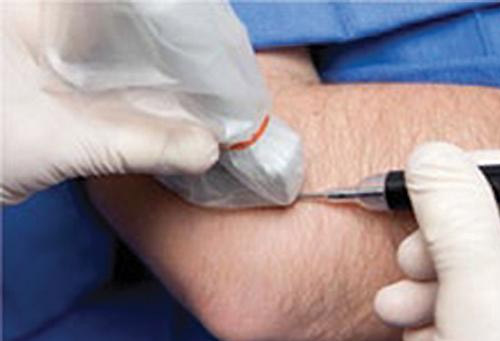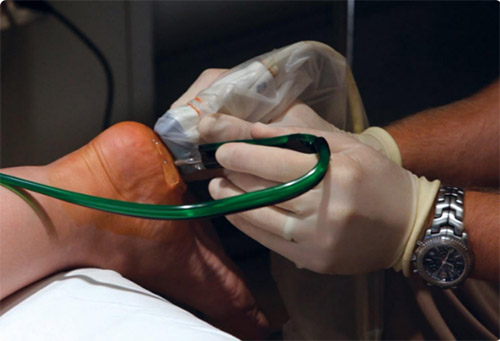Is Elbow or Heel Pain Stopping you?
Golfers elbow (inner elbow pain) is a commonly encountered orthopedic problem. It may affect as many as 8% of patients. Tennis elbow (outer elbow pain) effects up to 3% of adults each year. Plantar fasciitis is the most common cause of heel pain. It is estimated that 1 in 10 persons may experience this heel pain at some time. Nearly two million patients receive treatment for plantar fasciitis each year in the United States, comprising 1% of all visits to orthopedic surgeons.

Repetitive stress on the tendon-bone interface results in microtrauma and degeneration. Symptoms include pain, accompanied with swelling and decreased range of motion. Treatments include icing, anti-inflammatories, compressive wraps, physical therapy, night splints and extension braces. Corticosteroid injections are often required if more conservative methods fail to relieve symptoms.
If these symptoms persist, surgical debridement is considered. Traditional, open surgical treatment may require postoperative splinting and several weeks of recovery. This also comes with the possibility of complications, such as infections and wound healing problems.
If you or members of your family have been suffering with this type of pain, a newer, minimally invasive, and effective procedure is now available. Tenex Health offers a treatment based on advanced technology developed in collaboration with the Mayo Clinic. This minimally invasive procedure can treat your damaged tendon tissue, leaving healthy tissue undisturbed1,2 and promote a healing response3. This is performed in a minimally invasive fashion, often under local anesthetic.

The Tenex Health ’s TX® System combines ultrasound imaging to specifically target damaged tissue with the advanced TX MicroTip, an instrument designed for cutting and removal of diseased soft tissue that causes pain, and facilitates the restoration of natural tendon and soft tissue function. No stitches are required. The procedure is quick, performed in minutes and facilitates rapid pain relief and typical recovery within 6 to 8 weeks, to return to normal activities.
How does Tenex Health TX compare to open surgery? The goal of an open or arthroscopic approach is to visualize, cut and remove the damaged soft tissue. The goal of Tenex Health TX is to replicate this approach but in a minimally invasive manner. Open surgery often requires an OR suite with general anesthesia and support. In addition, the patient has a prolonged recovery that requires extensive physical therapy. The success rate for the open surgical procedure is around 50-60% and recovery of approximately 6 months.
Published clinical studies on the Tenex Health TX treatment reveal improvement from pain within 2 weeks, sustained through 12 months post-treatment and 95% of patients pain-free up to the final point of measurement,4 as well as statistically significant pain relief at 6 weeks post-treatment, sustained at the 12 month follow-up period. No device or patient related complications were reported in these studies. The low complication rate is attributed to the safety of the device, the minimally invasive approach and the ultrasound imaging that precisely identifies the diseased area.
Dr. Randy Clark and Dr. Aaron O’Brien are trained to perform this innovative procedure. This procedure is not only effective for tendinitis around the elbow, but jumper’s knee, plantar fasciitis, Achilles tendinitis, hip bursitis and even calcific tendinitis of the shoulder.
If you are looking for options different than traditional surgery, please schedule a consultation today, Coral Desert Orthopedics, 435-628-9393.
- O’Daly, B., et. al. High-power low-frequency ultrasound: A review of tissue dissection and ablation in medicine and surgery. Journal of Materials Processing Technology, 2008.
- Cimino, W.W., et. al., Physics of Ultrasonic Surgery Using Tissue Fragmentation: Part I, Ultrasound in Medicine & Biology, 1996.
- Kamineni, S., et. al., Percutaneous ultrasonic debridement of tendinopathy—a pilot Achilles rabbit model, Journal of Orthopaedic Surgery and Research, 2015.
- Koh, J., Fasciotomy and Surgical Tenotomy for Recalcitrant Lateral Elbow Tendinopathy, Am. Journal of Sports Medicine, 2013.
- Barnes, D., et. al., Ultrasonic Percutaneous Tenotomy for Chronic Elbow Tendonosis: a Prospective Study, Journal of Shoulder and Elbow Surgery, 2015.





















